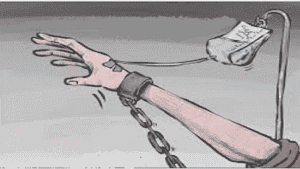by Jason Tarnow | May 20, 2020 | Crime, Criminal Attorney, Legal Aid, Legal Rights, Media, Police, Social Media, Wheels Of Justice
It goes without saying that the judicial system has been hit hard by COVID-19. This isn’t wildly surprising – there was no solid emergency response strategy in place for a situation like this, and as a result, a significant amount of time and resources have been expended to create a sense of control amongst the chaos.
It was acknowledged early on that certain individuals in the justice system would be disproportionately effected – accused persons in custody awaiting trial or sentencing, residents of remote communities that operate under a court circuit, and, of course, the victims in cases where there is uncertainty of if or when the case proceeds at all.
Since the World Health Organization declared a pandemic in response to COVID-19, law enforcement has tried to adapt where required. One of the most profound changes relates to the processing of newly accused individuals – and it may provide context into why intimate partner violence has surged during the pandemic. Between April 6 and May 6, 2020, 8 tragic incidents of domestic violence against women across Canada resulted in fatalities. There is, of course, no doubt about the fact that violence in relationships occurred before COVID-19, and will continue long after the pandemic is declared over – but there are aspects to a surge in intimate partner violence that are directly linked to the virus and to the policies that have been implemented when trying to process, manage, and supervise offenders.
Hundreds of accused persons awaiting trial in custody have been released, with chargeable offences ranging from assault, fraud, drug trafficking and beyond. Again, not surprising – as we’ve discussed previously on the blog, the correctional system serves as the perfect breeding ground for the virus, and it would be beyond cruel and unusual to take no action at all to protect those that are considered to be among the most vulnerable.
It’s the way that law enforcement has chosen to operate on a “catch and release” scheme in cases that would, under normal circumstances, require a bail hearing – and probably a highly contested one at that – that has likely contributed to domestic violence rates during COVID-19. Due to concerns about the nature of the virus and its ability to spread quickly, bail hearings have occurred less frequently, even with video-conferencing and telephone conferencing put into effect to streamline the process and protect the health of all parties involved. Instead of a bail hearing, an accused is more likely to be released on an Undertaking. The Undertaking may require that the accused check in with a bail supervisor weekly – something that is generally done on an in-person basis, where the most value lies in a face-to-face meeting – by telephone instead.

Aside from that, the “stay at home” order has, unintentionally, resulted in many victims of violence becoming prisoners in their homes. Public services like shelters and safe houses are stretched beyond capacity, and for some (especially people with underlying health conditions and people with children) entering into such an environment during a virus pandemic might seem even less tolerable than continuing to cohabitate with their abuser.
As with the other aspects of our lives – returning to work and school, chatting with our neighbors, planning vacations – the judicial system will, in one way or another, return to full operational capacity. But for those who have suffered the effects of intimate partner violence during the pandemic, there may be no return to the way things once were.
by Jason Tarnow | Apr 21, 2020 | Crime, Criminal Attorney, Legal Aid, Legal Rights, Media, Politics, Uncategorized, Wheels Of Justice
It has been over one month since the Courts of British Columbia significantly curtailed operations in an attempt to combat COVID-19.

For many of those who work in the legal field, it was this development that made it all real. It quickly became clear that the novel coronavirus had the potential to spread quickly, and the confined space of a courtroom serves as ideal grounds for transmission.
Despite the coronavirus acting as a proverbial wrench in the gears of justice, the judicial system continues to putter along. This is largely due to increased utilization of technological tools like video/conferencing for court appearances and swearing of affidavits, and relaxing restrictions when it comes to fax/electronic filing of court documents.
Video conferencing isn’t new to the BC court system. As early as 2002, Judges across the province agreed that the technology improved procedural efficiency by facilitating witness testimony from distant locations and allowing interim appearances by video involving counsel from other jurisdictions. Judges also noted the value of video- conferencing for inmates at correctional centres – defeating the purpose of transferring multiple inmates from various correctional centres to various courthouses. The bottom line is that modernizing certain aspects of the criminal justice system makes sense financially and systemically – and events like COVID-19 demonstrate how it can have occupational benefits too.
At present, there is enormous value in modernizing certain judicial processes for two reasons – one, to limit face-to-face interactions between judicial staff, defence counsel and an Accused person, and two, to mitigate the consequences of what can only be described as colossal delay.
In reducing operations, the majority of criminal trials scheduled between March 18, 2020 and June 1, 2020, have been adjourned generally to dates in June and July, 2020. Cases that are deemed to be of an urgent nature will be able to proceed, although in a procedural sense, things will look different – for example, witnesses who would ordinarily appear before the Court to give evidence may be authorized to testify via video. For the most part, however, trials will proceed at a date that is likely much later than originally anticipated.

The situation is more grim for accused persons in custody awaiting their trial. Inmates are, of course, among the most vulnerable to contracting the novl coronavirus – a concern that was a topic of discussion before the courts closed – but didn’t really become part of the actual narrative until it was too late Trials for accused persons in custody have also been adjourned (for trials scheduled between March 23 and May 16, 2020). Sentencing hearings and bail hearings for accused persons will proceed. This could be positive – for some, it might result in their immediate release from the correctional system. For others, further incarceration for as little as an additional 90 days in custody will be devastating, a potential death sentence.
It is far too early to gauge how overwhelmed the court system will be at the return to business as usual – but when you consider that there was a huge backlog before COVID-19 shut it all down, it seems only reasonable that extreme measures – such as implementing night/weekend court, and permanently authorizing certain modernization measures – will need to be taken to truly return to normal.



